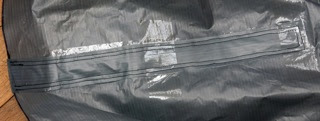Yesterday, I was able to spend nearly the full day working on Shan Skailyn. Shannon (my wife) and the kids were all busy with other stuff and gone much of the day. Only restrictions had to do with baby Abigail and her naps. No tools during naps!
So I finished cutting and planing the chines and the last little bit on the gunwales. I sorted through a bunch of other lumber and pulled out what I'll be using for the bulkhead perimeters, stems, seat supports and the like. Will be using a bunch of cutoff pieces from when we installed our floor. It's all 3/4" x 4" mixed hardwood tongue and groove flooring cutoffs, including stuff like kwila (ironwood), mahogany, and other standard hardwoods found here in Papua New Guinea. I tried to divvy them up so that the hardest stuff (ie. kwila) is to be used for the ama struts and the sides of the bulkhead perimeters where the bolts will be passing through. Then I'll want the lighter weight stuff to be used in all the other places.
Still haven't determined what I'll use for the iakos. Actually contemplating using bamboo, but I remember reading that Gary Dierking's concern with using those is that unless a way is found to provide structural support at the lashing points, that may be a major weakness. The walls of bamboo can be prone to crushing under such strain as the iakos experience. Will have to think about that and also experiment with bending the bamboo. I'm perfectly happy to do the either the laminated solid iakos or the hollow box frame construction like in Gary's book, but it seems that bamboo would be the lightest option if it would be strong enough at the lashing points and formable enough to get the downward curve at the ends.
I also managed yesterday afternoon to cut the sail out of my tarp material. Moved all the furniture out of the living area in our house. The kids were around then and thought it was a blast! So we laid out the sail, cut it, and even sewed the leech seam as well as a single dart in the foot and one in the tack (for the equivalent of the broad seam).
One thing I'm very concerned about at this point, and would LOVE to get some feedback on before proceeding any further) is whether or not sewing is the best option on this tarp. This polytarp is not of the woven variety. It's a solid piece of plastic. Same material, just not woven. Well my fear has been that sewing the unwoven stuff would actually serve only to act as a perforation line, making for a weak spot in the sail where it will be likely to tear. Well on my test pieces, I'm finding that to be true. It takes quite a bit of pulling to make it happen, but it does tear right along the stitches. It does require strong pulling for it to tear, but it always tears along the stitch. One thing I'm thinking about (assuming I decide to keep this material for the sail) is taping over all the seams as a backup, using either duct tape or packing tape. But I really would like for this sail to look nice if possible. Any ideas or thoughts out there? I need some help figuring out what the best long term solution will be here! If you have thoughts, post your comments!





This comment has been removed by the author.
ReplyDeleteI like the taping myself, used it on a small sprit, http://www.flsail.com/things-that-work-topmenu-37/22-tools-that-work/28-polytarp-sprit-sail.html.
ReplyDeleteAlso I have seen people use an old clothes or soldering iron to fuse the plastic. I can't find the link now, but if you search for it you may.
I made hollow wood iakos for my Ulua and they are wonderfully light. I cut curved sides from 6mm ply, used hardwood for top and bottom. I cut 6mm deep rebates half way through the thickness on the edges of the hardwood which helped locate the pieces when gluing, and gave more gluing area. Solid blocks inside at each end and where iakos cross gunwales. Wrapped ends with fibreglass tape. Two small blocks epoxy glued to underside of iakos sit outside gunwales and locate iakos. Mast partner made to bolt over the outside of the front iako, ie no holes through iakos. They are light, strong, and look great varnished. Cheers Dave
ReplyDelete